实验三-周期信号的频谱分析-实验报告
信号与系统分析实验信号的频谱分析
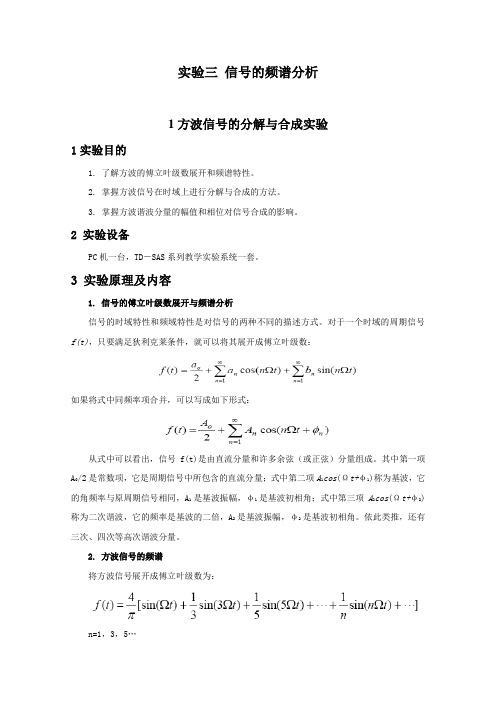
实验三信号的频谱分析1方波信号的分解与合成实验1实验目的1. 了解方波的傅立叶级数展开和频谱特性。
2. 掌握方波信号在时域上进行分解与合成的方法。
3. 掌握方波谐波分量的幅值和相位对信号合成的影响。
2 实验设备PC机一台,TD-SAS系列教学实验系统一套。
3 实验原理及内容1. 信号的傅立叶级数展开与频谱分析信号的时域特性和频域特性是对信号的两种不同的描述方式。
对于一个时域的周期信号f(t),只要满足狄利克莱条件,就可以将其展开成傅立叶级数:如果将式中同频率项合并,可以写成如下形式:从式中可以看出,信号f(t)是由直流分量和许多余弦(或正弦)分量组成。
其中第一项A0/2是常数项,它是周期信号中所包含的直流分量;式中第二项A1cos(Ωt+φ1)称为基波,它的角频率与原周期信号相同,A1是基波振幅,φ1是基波初相角;式中第三项A2cos(Ωt+φ2)称为二次谐波,它的频率是基波的二倍,A2是基波振幅,φ2是基波初相角。
依此类推,还有三次、四次等高次谐波分量。
2. 方波信号的频谱将方波信号展开成傅立叶级数为:n=1,3,5…此公式说明,方波信号中只含有一、三、五等奇次谐波分量,并且其各奇次谐波分量的幅值逐渐减小,初相角为零。
图3-1-1为一个周期方波信号的组成情况,由图可见,当它包含的分量越多时,波形越接近于原来的方波信号,还可以看出频率较低的谐波分量振幅较大,它们组成方波的主体,而频率较高的谐波分量振幅较小,它们主要影响波形的细节。
(a)基波(b)基波+三次谐波(c)基波+三次谐波+五次谐波(d)基波+三次谐波+五次谐波+七次谐波(e)基波+三次谐波+五次谐波+七次谐波+九次谐波图3-1-1方波的合成3. 方波信号的分解方波信号的分解的基本工作原理是采用多个带通滤波器,把它们的中心频率分别调到被测信号的各个频率分量上,当被测信号同时加到多路滤波器上,中心频率与信号所包含的某次谐波分量频率一致的滤波器便有输出。
信号实验报告word版

信号实验报告学院(系):专业:班级:姓名:学号:组:实验时间:实验室:实验台:指导教师签字:成绩:实验1信号的频谱图一、实验目的和要求1. 掌握周期信号的傅里叶级数展开2. 掌握周期信号的有限项傅里叶级数逼近3. 掌握周期信号的频谱分析4. 掌握连续非周期信号的傅立叶变换5. 掌握傅立叶变换的性质二、实验原理和内容2、非周期信号的傅里叶级数实验一信号的频谱图一、实验目的和要求1. 掌握周期信号的傅里叶级数展开2. 掌握周期信号的有限项傅里叶级数逼近3. 掌握周期信号的频谱分析4. 掌握连续非周期信号的傅立叶变换5. 掌握傅立叶变换的性质二、实验目的和要求t=-3:0.01:3;n0=-3;n1=-1;t0=2;for i=0:2t1=n0:0.01:n0+t0/2;x1=t1-n0;t2=n1-t0/2:0.01:n1;x2=-t2+n1;plot(t1,x1,'r',t2,x2,'r');hold on; n0=n0+t0;n1=n1+t0;endn_max=[1 3 7 15 31];N=length(n_max);for k=1:Nn=1; sum=0;while (n<(n_max(k)+1))b=4./pi/pi/n/n;y=b*cos(n*pi*t);sum=sum+y;n=n+2;endfigure;n0=-3;n1=-1;t0=2;for i=0:2t1=n0:0.01:n0+t0/2;x1=t1-n0;t2=n1-t0/2:0.01:n1;x2=-t2+n1;plot(t1,x1,'r',t2,x2,'r');hold on; n0=n0+t0;n1=n1+t0;endy=sum+0.5;plot(t,y,'b');xlabel('t'),ylabel('wove');hold off;axis([-3.01 3.01 -0.01 1.01]);grid on;title(['the max=',num2str(n_max(k))]) end0.10.20.30.40.50.60.70.80.910.10.20.30.40.50.60.70.80.91twove0.10.20.30.40.50.60.70.80.91twove0.10.20.30.40.50.60.70.80.91twove解:n=-30:30;tao=1;T=2;w=2*pi/T;x=n*tao*0.5fn1=sinc(x/pi);fn=tao*fn1.*fn1;subplot(3,1,1),stem(n*w,fn);grid on; axis([-30 30 0 1]);title(['tao=1 T=2'])n=-30:30;tao=3;T=5;w=2*pi/T;x=n*tao*0.5fn1=sinc(x/pi);fn=tao*fn1.*fn1;subplot(3,1,1),stem(n*w,fn);grid on; axis([-30 30 0 5]);title(['tao=3 T=5']);n=-30:30;tao=4;T=8;w=2*pi/T;x=n*tao*0.5fn1=sinc(x/pi);fn=tao*fn1.*fn1;subplot(3,1,1),stem(n*w,fn);grid on; axis([-30 30 0 9]);title(['tao=4 T=8']);解:(1)ft=sym('sin(2*pi*(t-1))/(pi*(t-1))'); Fw=fourier(ft)subplot(211);ezplot(abs(Fw));grid on;title('幅度谱');phase=atan(imag(Fw)/real(Fw)); subplot(212);ezplot(phase);grid on;title('相位谱');(2)ft=sym('(sin(pi*t)/(pi*t))^2'); Fw=fourier(ft);subplot(211);ezplot(abs(Fw));grid on;title('幅度谱');phase=atan(imag(Fw)/real(Fw)); subplot(212);ezplot(phase);grid on;title('相位谱');解:(1)syms tFw=sym('10/(3+i*w)-4/(5+i*w)') ft=ifourier(Fw,t)ezplot(ft);grid on;(2)syms tFw=sym('exp(-4*w^2)') ft=ifourier(Fw,t) ezplot(ft);grid on;解:dt = 0.01;t = -0.5:dt:0.5;ft = uCT(t+0.5)-uCT(t-0.5); N = 2000;k = -N:N;W = 2*pi*k/((2*N+1)*dt);F = dt * ft*exp(-j*t'*W); axis[-400 400 -0.4 1]plot(W,F), grid on-400-300-200-1000100200300400-0.4-0.20.20.40.60.81三、 实验体会实验中,第一次接触了MATLAB ,刚开始时用的不是很顺利,但之后才发现MATLAB 功能的强大,通过对例题的实际操作,相信以后的实验会越来越顺利。
信号的频谱分析
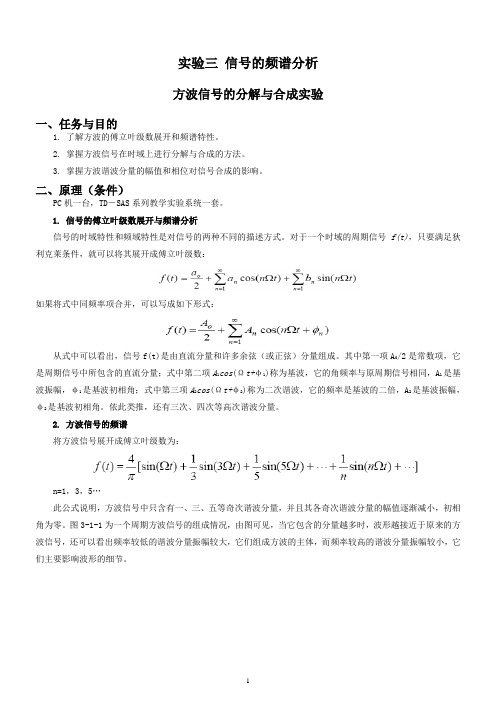
实验三信号的频谱分析方波信号的分解与合成实验一、任务与目的1. 了解方波的傅立叶级数展开和频谱特性。
2. 掌握方波信号在时域上进行分解与合成的方法。
3. 掌握方波谐波分量的幅值和相位对信号合成的影响。
二、原理(条件)PC机一台,TD-SAS系列教学实验系统一套。
1. 信号的傅立叶级数展开与频谱分析信号的时域特性和频域特性是对信号的两种不同的描述方式。
对于一个时域的周期信号f(t),只要满足狄利克莱条件,就可以将其展开成傅立叶级数:如果将式中同频率项合并,可以写成如下形式:从式中可以看出,信号f(t)是由直流分量和许多余弦(或正弦)分量组成。
其中第一项A0/2是常数项,它是周期信号中所包含的直流分量;式中第二项A1cos(Ωt+φ1)称为基波,它的角频率与原周期信号相同,A1是基波振幅,φ1是基波初相角;式中第三项A2cos(Ωt+φ2)称为二次谐波,它的频率是基波的二倍,A2是基波振幅,φ2是基波初相角。
依此类推,还有三次、四次等高次谐波分量。
2. 方波信号的频谱将方波信号展开成傅立叶级数为:n=1,3,5…此公式说明,方波信号中只含有一、三、五等奇次谐波分量,并且其各奇次谐波分量的幅值逐渐减小,初相角为零。
图3-1-1为一个周期方波信号的组成情况,由图可见,当它包含的分量越多时,波形越接近于原来的方波信号,还可以看出频率较低的谐波分量振幅较大,它们组成方波的主体,而频率较高的谐波分量振幅较小,它们主要影响波形的细节。
(a)基波(b)基波+三次谐波(c)基波+三次谐波+五次谐波(d)基波+三次谐波+五次谐波+七次谐波(e)基波+三次谐波+五次谐波+七次谐波+九次谐波图3-1-1方波的合成3. 方波信号的分解方波信号的分解的基本工作原理是采用多个带通滤波器,把它们的中心频率分别调到被测信号的各个频率分量上,当被测信号同时加到多路滤波器上,中心频率与信号所包含的某次谐波分量频率一致的滤波器便有输出。
周期信号分析实验报告(廖文平)-ok
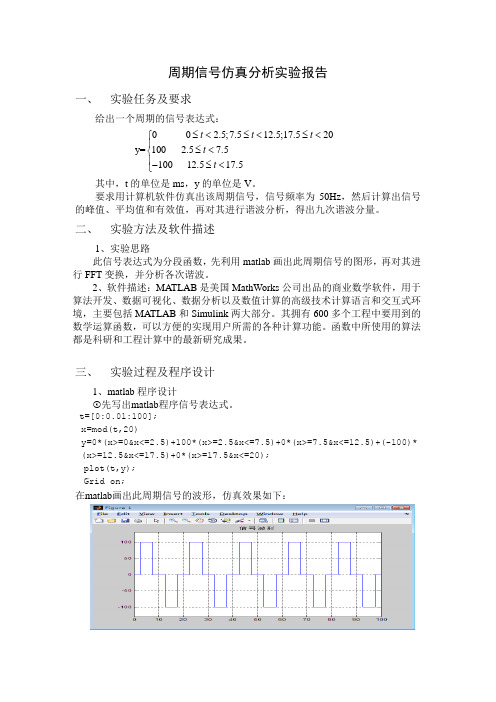
周期信号仿真分析实验报告一、实验任务及要求给出一个周期的信号表达式:y=00 2.5;7.512.5;17.520 100 2.57.510012.517.5t t ttt≤<≤<≤<⎧⎪≤<⎨⎪-≤<⎩其中,t的单位是ms,y的单位是V。
要求用计算机软件仿真出该周期信号,信号频率为50Hz,然后计算出信号的峰值、平均值和有效值,再对其进行谐波分析,得出九次谐波分量。
二、实验方法及软件描述1、实验思路此信号表达式为分段函数,先利用matlab画出此周期信号的图形,再对其进行FFT变换,并分析各次谐波。
2、软件描述:MATLAB是美国MathWorks公司出品的商业数学软件,用于算法开发、数据可视化、数据分析以及数值计算的高级技术计算语言和交互式环境,主要包括MATLAB和Simulink两大部分。
其拥有600多个工程中要用到的数学运算函数,可以方便的实现用户所需的各种计算功能。
函数中所使用的算法都是科研和工程计算中的最新研究成果。
三、实验过程及程序设计1、matlab程序设计先写出matlab程序信号表达式。
t=[0:0.01:100];x=mod(t,20)y=0*(x>=0&x<=2.5)+100*(x>=2.5&x<=7.5)+0*(x>=7.5&x<=12.5)+(-100)* (x>=12.5&x<=17.5)+0*(x>=17.5&x<=20);plot(t,y);Grid on;在matlab画出此周期信号的波形,仿真效果如下:②再利用matlab自带的程序求最大值、最小值、有效值。
在这里用max()函数求得最大值,用min()函数求得最小值,再在一个周期内求得均方根,即有效值。
其程序如下(先在一个周期内,便于求有效值):t=[0:0.01:20];x=mod(t,20)y=0*(x>=0&x<=2.5)+100*(x>=2.5&x<=7.5)+0*(x>=7.5&x<=12.5)+(-100)*( x>=12.5&x<=17.5)+0*(x>=17.5&x<=20);plot(t,y);axis([0 100 -130 130])title('信号波形');grid on ;A=max(y);disp('最大值=')disp(A);V=mean(y);disp('最小值=');disp(V);U=sqrt(sum(y.^2)/length(y));disp('有效值=');disp(U);仿真结果如下(在命令窗口显示):③再利用matlab自带的函数进行频谱分析。
周期信号频谱分析

实验名称:周期信号的频谱分析教材名称:电工电子实验技术(下册)页码:P142 实验目的:1、了解和掌握周期信号频谱分析的基本概念;2、掌握Multisim软件用于频谱分析的基本方法;3、加深理解周期信号时域参数变化对其谐波分量的影响及变化趋势。
实验任务:1、根据9-1给定的波形和参数测量各谐波分量的幅度值。
2、根据所测数据绘制每一波形的谱线图。
设计提示:实验电路图:图一、分析用电路及信号发生器调整窗口实验结果:表9-1数据:周期信号的频谱分析(Multisim)0 10 20 30 40 50 60 70 80 90 100 矩形波10%-4.023 1.923 1.833 1.689 1.499 1.273 1.024 0.763 0.506 0.263 0.047 矩形波30%-2.023 5.123 3.040 0.699 0.897 1.271 0.659 0.236 0.739 0.595 0.046 矩形波50%-0.022 6.366 0.045 2.121 0.045 1.271 0.045 0.906 0.045 0.703 0.045 正弦波0 4.999 0 0 0 0 0 0 0 0 0三角波50%0 4.053 0 0.451 0 0.162 0 0.083 0 0.050 0三角波70%0 3.903 1.147 0.166 0.177 0.193 0.079 0.030 0.072 0.048 0三角波90%0 3.479 1.654 1.012 0.669 0.450 0.298 0.186 0.103 0.043 0N 0 1 2 3 4 5 6 7 8 9 10 注:谱线数取10+直流。
矩形波10%:矩形波30%:矩形波50%:正弦波50%:三角波50%:三角波70%:三角波90%:实验中注意事项:1、仿真过程中要在Simulate/Fourier Analysis/Output Variables中添加要进行分析的节点。
《信号与系统》实验三
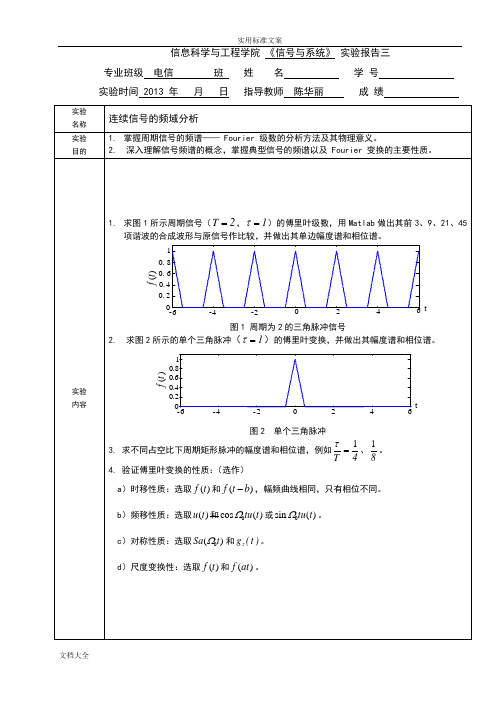
三:
源程序:
(1):τ/T=1/4时的周期矩形脉冲的幅度谱和相位谱:
n=-20:20;
F=zeros(size(n));
forii=-20:20
F(ii+21)= sin(ii*pi/4)/(ii*pi+eps);
end
F(21)=1/4;
实验
内容
1.求图1所示周期信号( , )的傅里叶级数,用Matlab做出其前3、9、21、45项谐波的合成波形与原信号作比较,并做出其单边幅度谱和相位谱。
图1 周期为2的三角脉冲信号
2. 求图2所示的单个三角脉冲( )的傅里叶变换,并做出其幅度谱和相位谱。
图2 单个三角脉冲
3. 求不同占空比下周期矩形脉冲的幅度谱和相位谱,例如 、 。
y=1/4;
forn=1:m
y=y+4/(n*n*pi*pi)*(1-cos(n*pi/2)).*cos(n*pi.*t);
end
源代码:
t=-6:0.01:6;
d=-6:2:6;
fxx=pulstran(t,d,'tripuls');
f1=fourierseries(3,t);
f2=fourierseries(9,t);
n=1:10;
a=zeros(size(n));
fori=1:10
a(i)=angle(4/(i*i*pi*pi)*(1-cos(i*pi/2)))
end
n=0:pi:9*pi
stem(n,a,'fill','linewidth',2);
axis([0,9*pi,-0.2,0.2])
利用FFT对信号进行频谱分析

∑-=--==101,....,0,)(1)(N k nk N N n W k X N n x (3.2) 离散傅立叶反变换与正变换的区别在于N W 变为1-N W ,并多了一个N 1的运算。
因为N W 和1-N W 对于推导按时间抽取的快速傅立叶变换算法并无实质性区别,因此可将FFT 和快速傅立叶反变换(IFFT )算法合并在同一个程序中。
2.利用FFT 进行频谱分析若信号本身是有限长的序列,计算序列的频谱就是直接对序列进行FFT 运算求得)(k X ,)(k X 就代表了序列在[]π2,0之间的频谱值。
幅度谱 )()()(22k X k X k X I R +=相位谱 )()(arctan )(k X k X k R I =ϕ 若信号是模拟信号,用FFT 进行谱分析时,首先必须对信号进行采样,使之变成离散信号,然后就可按照前面的方法用FFT 来对连续信号进行谱分析。
按采样定理,采样频率s f 应大于2倍信号的最高频率,为了满足采样定理,一般在采样之前要设置一个抗混叠低通滤波器。
用FFT 对模拟信号进行谱分析的方框图如下所示。
3.在运用DFT 进行频谱分析的过程中可能产生三种误差:(1)混叠序列的频谱是被采样信号频谱的周期延拓,当采样速率不满足Nyquist 定理时,就会发生频谱混叠,使得采样后的信号序列频谱不能真实的反映原信号的频谱。
避免混叠现象的唯一方法是保证采样速率足够高,使频谱混叠现象不致出现,即在确定采样频率之前,必须对频谱的性质有所了解。
在一般情况下,为了保证不出现频谱混叠,在采样前,先进行抗混叠滤波。
(2)泄漏实际中我们往往用截短的序列来近似很长的甚至是无限长的序列,这样可以使用较短的DFT 来对信号进行频谱分析,这种截短等价于给原信号序列乘以一个矩形窗函数,也相当于在频域将信号的频谱和矩形窗函数的频谱卷积,所得的频谱是原序列频谱的扩展。
抗混叠低通滤波器 采样T=1/f s N 点FFT泄漏不能与混叠完全分开,因为泄漏导致频谱的扩展,从而造成混叠。
信号的频谱分析
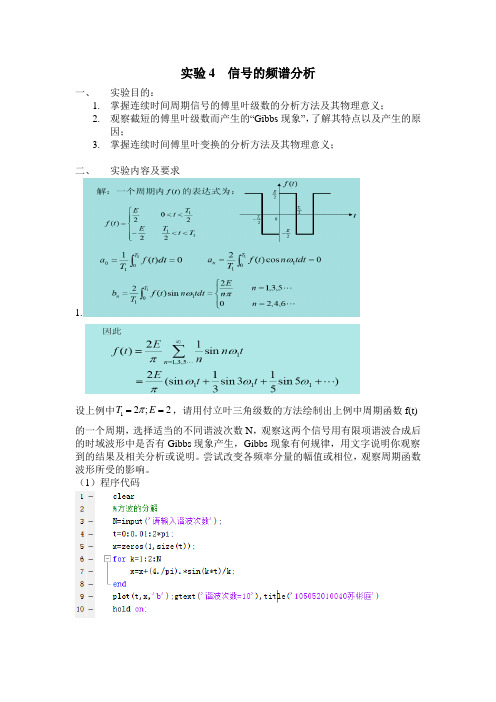
实验4 信号的频谱分析一、 实验目的:1. 掌握连续时间周期信号的傅里叶级数的分析方法及其物理意义;2. 观察截短的傅里叶级数而产生的“Gibbs 现象”,了解其特点以及产生的原因;3. 掌握连续时间傅里叶变换的分析方法及其物理意义;二、 实验内容及要求 1.设上例中12;2T E π==,请用付立叶三角级数的方法绘制出上例中周期函数f(t)的一个周期,选择适当的不同谐波次数N ,观察这两个信号用有限项谐波合成后的时域波形中是否有Gibbs 现象产生,Gibbs 现象有何规律,用文字说明你观察到的结果及相关分析或说明。
尝试改变各频率分量的幅值或相位,观察周期函数波形所受的影响。
(1)程序代码(2)实验结果(3)实验分析1、将具有不连续点如矩形脉冲进行傅立叶级数展开后,选取有限项进行合成。
在逼近信号的断点处出现了明显的振荡现象,随着谐波次数的增加,振荡并没有消失,反而更加的集中在断点附近。
2、当改变周期信号各频率上的幅值和相位时,周期函数的波形随幅值和相位发生对应的变化。
例:E=4,1Φ=,则图形的幅值就变成2,且向右平移一个单位。
2.采用数值计算算法分别计算非周期连续时间信号1f 的傅里叶变换.()()16f t g t =采用数值计算算法的理论依据是:()()()j t j nT n F j f t e dt f nT e T ωωω∞---∞==∑⎰,用绘图函数将时间信号f(t),信号的幅度谱|F(j w )|和相位谱∠F (j w )分别以图形的方式表现出来,并对图形加以适当的标注。
观察结果与理论推导是否相符,试图查找原因,并在一定程度上加以改善。
理论分析:()()6(3)j t F jw f t e dt Sa w ω∞--∞==⎰(1)程序代码(2)实验结果(3)实验分析理论分析与实验结果是一致的。
实验报告要求:1.列出本实验的所有文件及各项实验结果,加注必要的说明;2.对实验结果作理论解释;3.总结实验体会及实验存在的问题。
数字信处理实验三用FFT对信作频谱分析实验报告修订稿

数字信处理实验三用F F T对信作频谱分析实验报告Document number【SA80SAB-SAA9SYT-SAATC-SA6UT-SA18】实验三:用FFT对信号作频谱分析实验报告一、实验目的与要求学习用FFT对连续信号和时域离散信号进行谱分析的方法,了解可能出现的分析误差及其原因,以便正确应用FFT。
二、实验原理用FFT对信号作频分析是学习数字信号处理的重要内容,经常需要进行分析的信号是模拟信号的时域离散信号。
对信号进行谱分析的重要问题是频谱分辨率D和分析误差。
频谱分辨率直接和FFT的变换区间N有关,因为FFT能够实现的频率分辨率是2π/N,因此要求2π/N小于等于D。
可以根据此式选择FFT的变换区间N。
误差主要来自于用FFT作频谱分析时,得到的是离散谱,而信号(周期信号除外)是连续谱,只有当N较大时,离散谱的包络才能逼近连续谱,因此N要适当选择大一些。
三、实验步骤及内容(含结果分析)1)对以下序列进行FFT分析:选择FFT的变换区间N为8和16两种情况进行频谱分析,分别打印出幅频特性曲线,并进行讨论、分析与比较。
程序:(1)选择FFT的变换区间N为8和16两种情况进行频谱分析,分别打印出幅频特性曲线,并进行讨论、分析与比较。
x1n=[ones(1,4)];%产生R4(n)序列向量X1k8=fft(x1n,8);%计算x1n的8点DFTX1k16=fft(x1n,16);%计算x1n的16点DFT%以下绘制幅频特性曲线N=8;f=2/N*(0:N-1);figure(1);subplot(1,2,1);stem(f,abs(X1k8),'.');%绘制8点DFT的幅频特性图title('(1a)8点DFT[x_1(n)]');xlabel('ω/π');ylabel('幅度');N=16;f=2/N*(0:N-1);subplot(1,2,2);stem(f,abs(X1k16),'.');%绘制8点DFT的幅频特性图title('(1a)16点DFT[x_1(n)]');xlabel('ω/π');ylabel('幅度');%x2n和x3nM=8;xa=1:(M/2);xb=(M/2):-1:1;x2n=[xa,xb];%产生长度为8的三角波序列x2(n)x3n=[xb,xa];X2k8=fft(x2n,8);X2k16=fft(x2n,16);X3k8=fft(x3n,8);X3k16=fft(x3n,16);figure(2);N=8;f=2/N*(0:N-1);subplot(2,2,1);stem(f,abs(X2k8),'.');%绘制8点DFT的幅频特性图title('(2a)8点DFT[x_2(n)]');xlabel('ω/π');ylabel('幅度');subplot(2,2,3);stem(f,abs(X3k8),'.');%绘制8点DFT的幅频特性图title('(3a)8点DFT[x_3(n)]');xlabel('ω/π');ylabel('幅度');N=16;f=2/N*(0:N-1);subplot(2,2,2);stem(f,abs(X2k16),'.');%绘制8点DFT的幅频特性图title('(2a)16点DFT[x_2(n)]');xlabel('ω/π');ylabel('幅度');subplot(2,2,4);stem(f,abs(X3k16),'.');%绘制8点DFT的幅频特性图title('(3a)16点DFT[x_3(n)]');xlabel('ω/π');ylabel('幅度');【实验结果】(2)对以下周期序列进行谱分析:x4(n)=cos[(π/4)*n]x5(n)=cos[(π/4)*n]+cos[(π/8)*n]选择FFT的变换区间N为8和16两种情况进行频谱分析,分别打印出幅频特性曲线,并进行讨论、分析与比较。
北京理工大学信号与系统实验报告3信号的频域分析报告

实验3 信号的频域分析(综合型实验)一、实验目的1)深入理解信号频谱的概念,掌握信号的频域分析方法。
2)观察典型周期信号和非周期信号的频谱,掌握其频谱特性。
二、实验原理与方法 1.连续周期信号的频谱分析如果周期信号满足Dirichlet 条件,就可展开为傅里叶级数的形式,即0(t)jk tkk x c eω+∞=-∞=∑(1) 0001(t)e jk tk T c x dt T ω-=⎰(2) 其中0T 表示基波周期,002/T ωπ=为基波频率,0(...)T ⎰表示任一个基波周期内的积分。
上面两式为周期信号复指数形式的傅里叶级数,系数k c 成为x(t)的傅里叶系数。
周期信号的傅里叶级数还可由三角函数的线性组合来表示,即00011(t)cos sin k k k k x a a k t b k t ωω+∞+∞===++∑∑(3)其中000000000122(t),(t)cosk ,(t)sink k k T T T a x dt a x tdt b x tdt T T T ωω===⎰⎰⎰(4) (3)式中同频率的正弦、余弦项合并可以得到三角函数形式的傅里叶级数,即001(t)cos(k t )k k k x A A ωθ+∞==++∑ (5)其中00,arctankk k kb A a A a θ===- (6) 任何满足Dirichlet 条件的周期信号都可以表示成一组谐波关系的复指数函数或三角函数的叠加。
周期信号表示为傅里叶级数时需要无限多项才能完全逼近原信号,但在实际应用中常采用有限项级数代替,所选级数项越多就越接近原信号。
2.连续非周期信号的频谱分析对于非周期连续时间信号,信号的傅里叶变换和傅里叶逆变换定义为()(t)ej tX x dt ωω+∞--∞=⎰(7)1(t)()e 2j t x X d ωωωπ+∞-∞=⎰(8)以上两式把信号的时频特性联系起来,确立了非周期信号(t)x 和频谱()X ω之间的关系。
实验三-周期信号的频谱分析-实验报告

实验三-周期信号的频谱分析-实验报告信号与系统实验报告实验三周期信号的频谱分析学院专业班级姓名学号指导教师实验报告评分:_______实验三周期信号的频谱分析一、实验目的1、掌握连续时间周期信号的傅里叶级数的物理意义和分析方法;2、观察截短傅里叶级数而产生的“Gibbs现象”,了解其特点以及产生的原因;3、掌握各种典型的连续时间非周期信号的频谱特征。
二、实验内容实验前,必须首先阅读本实验原理,读懂所给出的全部范例程序。
实验开始时,先在计算机上运行这些范例程序,观察所得到的信号的波形图。
并结合范例程序应该完成的工作,进一步分析程序中各个语句的作用,从而真正理解这些程序。
实验前,一定要针对下面的实验项目做好相应的实验准备工作,包括事先编写好相应的实验程序等事项。
Q3-1 编写程序Q3_1,绘制下面的信号的波形图:-+-=)5cos(51)3cos(31)cos()(000t t t t x ωωω∑∞==10)cos()2sin(1n t n n n ωπ其中,ω0 = 0.5π,要求将一个图形窗口分割成四个子图,分别绘制cos(ω0t)、cos(3ω0t)、cos(5ω0t) 和x(t) 的波形图,给图形加title ,网格线和x 坐标标签,并且程序能够接受从键盘输入的和式中的项数。
抄写程序Q3_1如下:clear,%Clear all variablesclose all,%Close all figure windowsdt = 0.00001; %Specify the step of time variablet = -2:dt:4; %Specify the interval of timew0=0.5*pi;x1=cos(w0.*t);x2=cos(3*w0.*t);x3=cos(5*w0.*t);N=input('Type in the number of the harmonic components N=');x=0;for q=1:N;x=x+(sin(q*(pi/2)).*cos(q*w0*t))/q;endsubplot(221)plot(t,x1)%Plot x1axis([-2 4 -2 2]);grid on,title('signal cos(w0.*t)')subplot(222)plot(t,x2)%Plot x2axis([-2 4 -2 2]);grid on,title('signal cos(3*w0.*t))')subplot(223)plot(t,x3)%Plot x3axis([-2 4 -2 2])grid on,title('signal cos(5*w0.*t))')执行程序Q3_1所得到的图形如下:Q3-2 给程序Program3_1增加适当的语句,并以Q3_2存盘,使之能够计算例题1中的周期方波信号的傅里叶级数的系数,并绘制出信号的幅度谱和相位谱的谱线图。
实验3-信号的频域分析
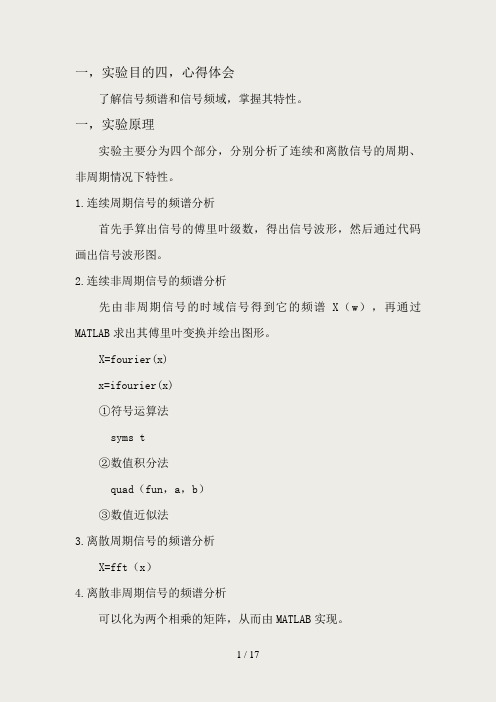
一,实验目的四,心得体会了解信号频谱和信号频域,掌握其特性。
一,实验原理实验主要分为四个部分,分别分析了连续和离散信号的周期、非周期情况下特性。
1.连续周期信号的频谱分析首先手算出信号的傅里叶级数,得出信号波形,然后通过代码画出信号波形图。
2.连续非周期信号的频谱分析先由非周期信号的时域信号得到它的频谱X(w),再通过MATLAB求出其傅里叶变换并绘出图形。
X=fourier(x)x=ifourier(x)①符号运算法syms t②数值积分法quad(fun,a,b)③数值近似法3.离散周期信号的频谱分析X=fft(x)4.离散非周期信号的频谱分析可以化为两个相乘的矩阵,从而由MATLAB实现。
三,实验内容(1)已知x(t)是如图周期矩形脉冲信号。
1).计算该信号的傅里叶级数。
2).利用MATLAB绘出由前N次谐波合成的信号波形,观察随着N的变化合成信号波形的变化规律。
3).利用MATLAB绘出周期矩形脉冲信号的频谱,观察参数T和τ变化时对频谱波形的影响。
思考下列问题:①什么是吉伯斯现象?产生吉伯斯现象的原因是什么?②以周期矩形脉冲信号为例,说明周期信号的频谱有什么特点。
③周期矩形脉冲信号参数τ/T的变化,其频谱结构(如频谱包络形状、过零点、频谱间隔等)如何变化?(2)已知x(t)是如图所示矩形脉冲信号。
1).求该信号的傅里叶变幻。
2). 利用MATLAB绘出周期矩形脉冲信号的频谱,观察参数T和τ变化时对频谱波形的影响。
3). 让矩形脉冲宽度始终等于一,改变矩形脉冲宽度,观察矩形脉冲信号时域波形和频谱随矩形脉冲宽度的变化趋势。
①比较矩形脉冲信号和周期矩形脉冲信号的频谱,两者之间有何异同。
②让矩形脉冲的面积始终等于一,改变矩形脉冲的宽度,观察矩形脉冲信号时域波形和频谱波形随矩形脉冲宽度的变化趋势。
(1)已知x(t)是如图所示的周期矩形脉冲信号①,计算该信号的傅里叶级数答:由图中x(t)波形可知信号为通过计算,可以知道所以x(t)的傅里叶级数为。
信号的频谱分析实验报告

实验四 信号的频谱分析一.实验目的1.掌握利用FFT 分析连续周期,非周期信号的频谱,如周期,非周期方波,正弦信号等。
理解CFS ,CTFT 与DFT (FFT )的关系。
2.利用FFT 分析离散周期,非周期信号的频谱,如周期,非周期方波,正弦信号等。
理解DFS ,DTFT 与DFT (FFT )的关系,并讨论连续信号与离散信号频谱分析方法的异同。
二.实验要求1.编写程序完成任意信号数字谱分析算法;2.编写实验报告。
三.实验内容1.利用FFT ,分析并画出sin(100),cos(100)t t ππ频谱,改变采样间隔与截断长度,分析混叠与泄漏对单一频率成分信号频谱的影响。
(1)sin (100*pi*t )产生程序:close all;clc;clear;t=0:0.0025:0.5-0.0025;f=400*t;w0=100*pi;y=sin(w0*t);a=fft(y);b=abs(a)/200;d=angle(a)*180/pi; subplot(311);plot(t,y);title('y=sin(wt)'); xlabel('t');ylabel('y(t)'); subplot(312); stem(f,b);title('振幅'); xlabel('f');ylabel('y(t)'); subplot(313); stem(f,d);title('相位'); xlabel('t');ylabel('y(t)');混叠close all;clc;clear;t=0:0.0115:0.46-0.0115; f=(t/0.0115)*2;w0=100*pi;y=sin(w0*t);a=fft(y);b=abs(a)/40;d=angle(a)*180/pi; subplot(311);plot(t,y);title('y=sin(wt)'); xlabel('t');ylabel('y(t)'); subplot(312); stem(f,b); title('振幅'); xlabel('f'); ylabel('y(t)'); subplot(313); stem(f,d); title('相位'); xlabel('t'); ylabel('y(t)');泄漏close all; clc;clear;t=0:0.0025:0.5-0.0075; f=800*t;w0=100*pi;y=sin(w0*t);a=fft(y);b=abs(a)/198;d=angle(a)*180/pi; subplot(311);plot(t,y);title('y=sin(wt)'); xlabel('t');ylabel('y(t)');subplot(312);stem(f,b);title('振幅');xlabel('f');ylabel('y(t)');subplot(313);stem(f,d);title('相位');xlabel('t');ylabel('y(t)');(2)cos(100*pi*t); close all;clc;clear;t=0:0.0025:0.5-0.0025; f=800*t;w0=100*pi;y=cos(w0*t);a=fft(y);b=abs(a)/200;d=angle(a)*180/pi; subplot(311);plot(t,y);title('y=cos(wt)'); xlabel('t');ylabel('y(t)');grid on; hold on; subplot(312); stem(f,b); title('振幅'); xlabel('f'); ylabel('y(t)'); grid on; hold on; subplot(313); stem(f,d); title('相位'); xlabel('f'); ylabel('y(t)');混叠close all;clc;clear;t=0:0.0115:0.46-0.0115; f=(t/0.0115)*2;w0=100*pi;y=cos(w0*t);a=fft(y);b=abs(a)/40;d=angle(a)*180/pi; subplot(311);plot(t,y);title('y=cos(wt)'); xlabel('t');ylabel('y(t)');subplot(312);stem(f,b);title('振幅');xlabel('f');ylabel('y(t)');subplot(313);stem(f,d);title('相位');ylabel('y(t)');泄漏close all;clc;clear;t=0:0.0025:0.5-0.0075; f=800*t;w0=100*pi;y=cos(w0*t);a=fft(y);b=abs(a)/198;d=angle(a)*180/pi; subplot(311);plot(t,y);title('y=cos(wt)');ylabel('y(t)');subplot(312);stem(f,b);title('振幅');xlabel('f');ylabel('y(t)');subplot(313);stem(f,d);title('相位');xlabel('t');ylabel('y(t)');2.利用FFT,分析并对比方波以及半波对称的正负方波的频谱,改变采样间隔与截断长度,分析混叠与泄漏对信号频谱的影响。
「实验三_周期信号的频谱分析」
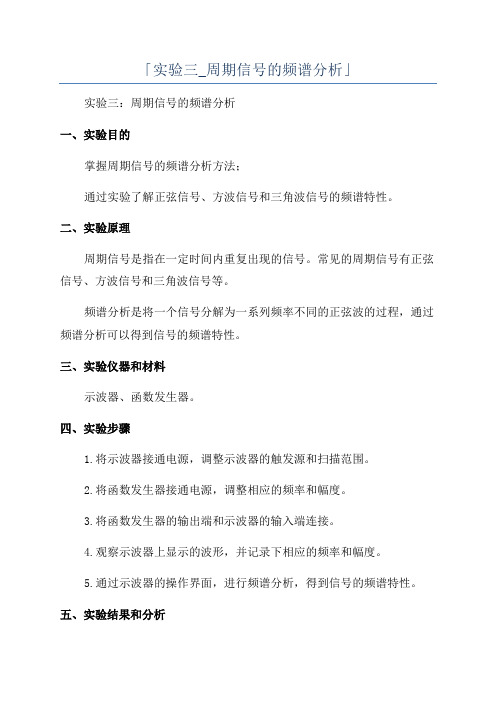
「实验三_周期信号的频谱分析」实验三:周期信号的频谱分析一、实验目的掌握周期信号的频谱分析方法;通过实验了解正弦信号、方波信号和三角波信号的频谱特性。
二、实验原理周期信号是指在一定时间内重复出现的信号。
常见的周期信号有正弦信号、方波信号和三角波信号等。
频谱分析是将一个信号分解为一系列频率不同的正弦波的过程,通过频谱分析可以得到信号的频谱特性。
三、实验仪器和材料示波器、函数发生器。
四、实验步骤1.将示波器接通电源,调整示波器的触发源和扫描范围。
2.将函数发生器接通电源,调整相应的频率和幅度。
3.将函数发生器的输出端和示波器的输入端连接。
4.观察示波器上显示的波形,并记录下相应的频率和幅度。
5.通过示波器的操作界面,进行频谱分析,得到信号的频谱特性。
五、实验结果和分析结果显示,正弦信号的频谱特性为单频信号,频率为1000Hz,幅度为2V。
结果显示,方波信号的频谱特性为含有多个奇次谐波的信号,相邻谐波之间的幅度逐渐减小。
结果显示,三角波信号的频谱特性为包含有一系列奇次和偶次谐波的信号,谐波的幅度逐渐减小。
六、实验结论通过实验,我们了解了正弦信号、方波信号和三角波信号的频谱特性。
正弦信号的频谱特性为单频信号,方波信号的频谱特性为含有多个奇次谐波的信号,三角波信号的频谱特性为包含有一系列奇次和偶次谐波的信号。
七、实验总结通过本次实验,我们对周期信号的频谱分析有了更深入的了解。
频谱分析是了解一个周期信号频率特征的重要手段,通过分析信号的频谱可以得到信号的频率分量和相应的幅度。
实验中我们主要观察了正弦信号、方波信号和三角波信号的频谱特性,并通过示波器进行了频谱分析。
通过实验可以直观地观察到不同类型信号的频谱特性,加深对周期信号的认识。
频谱的分析实验报告

一、实验目的1. 理解频谱分析的基本原理和方法;2. 掌握FFT(快速傅里叶变换)在频谱分析中的应用;3. 分析不同信号在时域和频域的特性;4. 学习利用MATLAB进行频谱分析。
二、实验原理频谱分析是信号处理中的重要手段,通过对信号的频谱进行分析,可以了解信号的频率成分、能量分布等信息。
傅里叶变换是频谱分析的核心,它可以将信号从时域转换为频域,揭示信号的频率特性。
FFT是一种高效的傅里叶变换算法,它可以将N点的DFT计算复杂度从O(N^2)降低到O(NlogN),在信号处理领域得到广泛应用。
三、实验内容1. 实验一:时域信号与频域信号的关系(1)利用MATLAB生成一个简单的正弦波信号,观察其时域波形和频谱;(2)改变正弦波的频率和幅度,观察时域波形和频谱的变化;(3)分析正弦波信号的频率成分和能量分布。
2. 实验二:利用FFT进行频谱分析(1)利用MATLAB生成一个含有多个频率成分的复合信号;(2)对复合信号进行FFT变换,观察其频谱;(3)分析复合信号的频率成分和能量分布;(4)对比不同FFT点数对频谱分析结果的影响。
3. 实验三:窗函数对频谱分析的影响(1)利用MATLAB生成一个矩形窗和汉宁窗,观察它们的时域波形;(2)对信号进行矩形窗和汉宁窗处理,分别进行FFT变换;(3)比较两种窗函数对频谱分析结果的影响。
四、实验结果与分析1. 实验一结果与分析实验结果显示,正弦波信号的时域波形为周期性的正弦波形,其频谱为离散的频率成分,频率为正弦波的频率。
改变正弦波的频率和幅度,时域波形和频谱相应地发生变化。
2. 实验二结果与分析实验结果显示,复合信号的频谱为多个频率成分的叠加,通过FFT变换可以清晰地观察到各个频率成分。
对比不同FFT点数对频谱分析结果的影响,FFT点数越多,频谱分辨率越高,但计算复杂度也随之增加。
3. 实验三结果与分析实验结果显示,矩形窗和汉宁窗的时域波形具有不同的形状,对信号进行窗函数处理可以降低边缘效应,提高频谱分析精度。
实验三用FFT对信号作频谱分析_实验报告
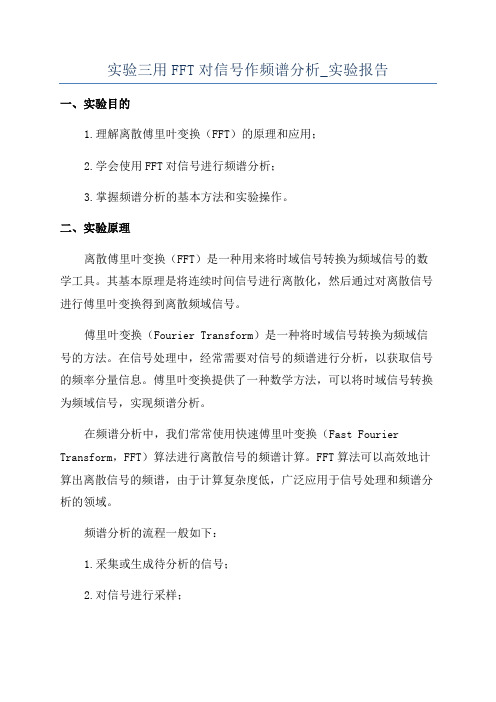
实验三用FFT对信号作频谱分析_实验报告一、实验目的1.理解离散傅里叶变换(FFT)的原理和应用;2.学会使用FFT对信号进行频谱分析;3.掌握频谱分析的基本方法和实验操作。
二、实验原理离散傅里叶变换(FFT)是一种用来将时域信号转换为频域信号的数学工具。
其基本原理是将连续时间信号进行离散化,然后通过对离散信号进行傅里叶变换得到离散频域信号。
傅里叶变换(Fourier Transform)是一种将时域信号转换为频域信号的方法。
在信号处理中,经常需要对信号的频谱进行分析,以获取信号的频率分量信息。
傅里叶变换提供了一种数学方法,可以将时域信号转换为频域信号,实现频谱分析。
在频谱分析中,我们常常使用快速傅里叶变换(Fast Fourier Transform,FFT)算法进行离散信号的频谱计算。
FFT算法可以高效地计算出离散信号的频谱,由于计算复杂度低,广泛应用于信号处理和频谱分析的领域。
频谱分析的流程一般如下:1.采集或生成待分析的信号;2.对信号进行采样;3.对采样得到的信号进行窗函数处理,以改善频谱的分辨率和抑制信号泄漏;4.使用FFT算法对窗函数处理得到的信号进行傅里叶变换;5.对傅里叶变换得到的频谱进行幅度谱和相位谱分析;6.对频谱进行解释和分析。
三、实验内容实验所需材料和软件及设备:1.信号发生器或任意波形发生器;2.数字示波器;3.计算机。
实验步骤:1.连接信号发生器(或任意波形发生器)和示波器,通过信号发生器发送一个稳定的正弦波信号;2.调节信号频率、幅度和偏置,得到不同的信号;3.使用数字示波器对信号进行采样,得到离散时间信号;4.对采样得到的信号进行窗函数处理;5.对窗函数处理得到的信号进行FFT计算,得到频谱;6.使用软件将频谱进行幅度谱和相位谱的分析和显示。
四、实验结果与分析1.信号频谱分析结果如下图所示:(插入实验结果图)从频谱图中可以看出,信号主要集中在一些频率上,其他频率基本没有,表明信号主要由该频率成分组成。
实验3 用FFT对信号作频谱分析

选择 采样频率 ,变换区间N=16,32,64 三种情况进行谱分析。分别打印其幅频特性,并进行分析和讨论。
4(思考题
(1)对于周期序列,如果周期不知道,如何用FFT进行谱分析, (2)如何选择FFT的变换区间,(包括非周期信号和周期信号) (3)当N=8时, 和 的幅频特性会相同吗,为什么,N=16 呢, 5(实验报告要求
%实验内容(1)===================================================
(1)完成各个实验任务和要求。附上程序清单和有关曲线。
(2)简要回答思考题。
=====================================================================
========Байду номын сангаас==
%第10章实验3程序exp3.m
% 用FFT对信号作频谱分析
clear all;close all
对模拟信号进行谱分析时,首先要按照采样定理将其变成时域离散信号。如果是模拟周期信号,也应该选取整数倍周期的长度,经过采样后形成周期序列,按照周期序列的谱分析进行。
3(实验步骤及内容
(1)对以下序列进行谱分析。
选择FFT的变换区间N为8和16 两种情况进行频谱分析。分别打印其幅频特性曲线。 并进行对比、分析和讨论。
(2)对以下周期序列进行谱分析。
选择FFT的变换区间N为8和16 两种情况分别对以上序列进行频谱分析。分别打印其幅频特性曲线。并进行对比、分析和讨论。
feel free to listen to their voices and help the masses solve problems, we were officially opened on May 10 "12345" Mayor calls, formulated rules and regulations, equipped with a full-time staff, a 24-hour on-duty system, people to call to receive, reply, action, reminders, feedback and so on. By year end, handled the crowd calls 1076, 94.7% feedback rate. By Mayor calls active coordination to solve a large number of bears on the immediate interests of the people and issues of great lives, but also for leadership research and decision to collect a lot of good ideas and suggestions, by all sectors of the community alike. Second, start Municipal Government Affairs Hall built. On May 11, we built and launched the city-government lobby, were settled in 12 departments, strict implementation of first asking duty system, service system, system of gratuitous, "receiving, internal coordination, head of the window handle, limited time concluded" one-stop service. By the end of today to accept various types of 3,273, originally of up to 100%. Running Government Affairs Hall, the convenience of the masses, promoting open Government, improve the investment environment and solve their practical problems, and so did a lot of work, masses, serve the community for the Government to play a very good "window, link, model". Third, create a city government public affairs network. We rely on theGovernment Web site, was completed on May 24, the province's first public affairs network. Over
实验三_周期信号的频谱分析
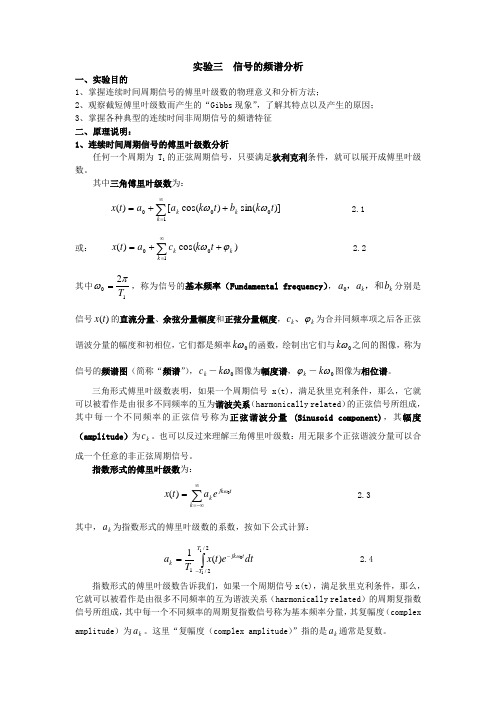
实验三 信号的频谱分析一、实验目的1、掌握连续时间周期信号的傅里叶级数的物理意义和分析方法;2、观察截短傅里叶级数而产生的“Gibbs 现象”,了解其特点以及产生的原因;3、掌握各种典型的连续时间非周期信号的频谱特征 二、原理说明:1、连续时间周期信号的傅里叶级数分析任何一个周期为T 1的正弦周期信号,只要满足狄利克利条件,就可以展开成傅里叶级数。
其中三角傅里叶级数为:∑∞=++=1000)]sin()cos([)(k k k t k b t k a a t x ωω 2.1或: ∑∞=++=100)cos()(k k kt k ca t x ϕω 2.2其中102T πω=,称为信号的基本频率(Fundamental frequency ),k k b a a ,和,0分别是信号)(t x 的直流分量、余弦分量幅度和正弦分量幅度,k k c ϕ、为合并同频率项之后各正弦谐波分量的幅度和初相位,它们都是频率0ωk 的函数,绘制出它们与0ωk 之间的图像,称为信号的频谱图(简称“频谱”),k c -0ωk 图像为幅度谱,k ϕ-0ωk 图像为相位谱。
三角形式傅里叶级数表明,如果一个周期信号x(t),满足狄里克利条件,那么,它就可以被看作是由很多不同频率的互为谐波关系(harmonically related )的正弦信号所组成,其中每一个不同频率的正弦信号称为正弦谐波分量 (Sinusoid component),其幅度(amplitude )为k c 。
也可以反过来理解三角傅里叶级数:用无限多个正弦谐波分量可以合成一个任意的非正弦周期信号。
指数形式的傅里叶级数为:∑∞-∞==k tjk kea t x 0)(ω 2.3其中,k a 为指数形式的傅里叶级数的系数,按如下公式计算:⎰--=2/2/1110)(1T T tjk k dt et x T a ω 2.4指数形式的傅里叶级数告诉我们,如果一个周期信号x(t),满足狄里克利条件,那么,它就可以被看作是由很多不同频率的互为谐波关系(harmonically related )的周期复指数信号所组成,其中每一个不同频率的周期复指数信号称为基本频率分量,其复幅度(complex amplitude )为k a 。
实验三用FFT对信号作频谱分析实验报告
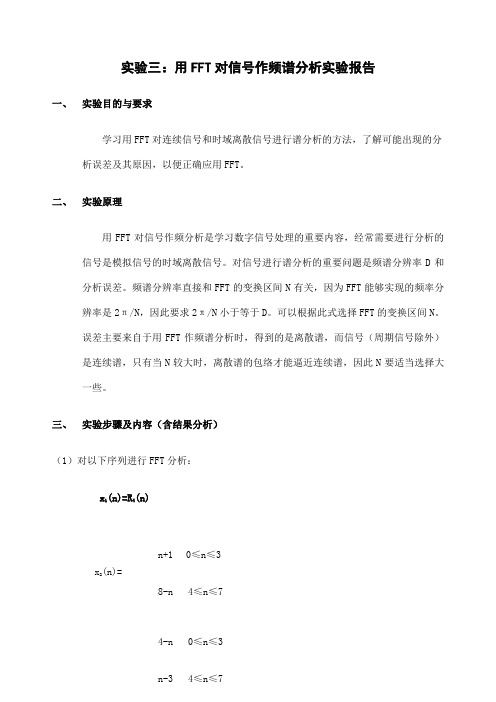
实验三:用FFT对信号作频谱分析实验报告一、实验目的与要求学习用FFT对连续信号和时域离散信号进行谱分析的方法,了解可能出现的分析误差及其原因,以便正确应用FFT。
二、实验原理用FFT对信号作频分析是学习数字信号处理的重要内容,经常需要进行分析的信号是模拟信号的时域离散信号。
对信号进行谱分析的重要问题是频谱分辨率D和分析误差。
频谱分辨率直接和FFT的变换区间N有关,因为FFT能够实现的频率分辨率是2π/N,因此要求2π/N小于等于D。
可以根据此式选择FFT的变换区间N。
误差主要来自于用FFT作频谱分析时,得到的是离散谱,而信号(周期信号除外)是连续谱,只有当N较大时,离散谱的包络才能逼近连续谱,因此N要适当选择大一些。
三、实验步骤及内容(含结果分析)(1)对以下序列进行FFT分析:x 1(n)=R4(n)x2(n)=n+1 0≤n≤38-n 4≤n≤74-n 0≤n≤3n-3 4≤n≤7x(n)=3选择FFT的变换区间N为8和16两种情况进行频谱分析,分别打印出幅频特性曲线,并进行讨论、分析与比较。
【实验结果如下】:实验结果图形与理论分析相符。
(2)对以下周期序列进行谱分析:x(n)=cos[(π/4)*n]4(n)= cos[(π/4)*n]+ cos[(π/8)*n]x5选择FFT的变换区间N为8和16两种情况进行频谱分析,分别打印出幅频特性曲线,并进行讨论、分析与比较。
【实验结果如下】:(3)对模拟周期信号进行频谱分析:(n)= cos(8πt)+ cos(16πt)+ cos(20πt)x6选择采样频率Fs=64Hz,FFT的变换区间N为16、32、64三种情况进行频谱分析,分别打印出幅频特性曲线,并进行讨论、分析与比较。
【实验结果如下】:四、【附录】(实验中代码)x1n=[ones(1,4)]; %产生R4(n)序列向量X1k8=fft(x1n,8); %计算x1n的8点DFTX1k16=fft(x1n,16); %计算x1n的16点DFT%以下绘制幅频特性曲线N=8;f=2/N*(0:N-1);figure(1);subplot(1,2,1);stem(f,abs(X1k8),'.'); %绘制8点DFT的幅频特性图title('(1a) 8点DFT[x_1(n)]');xlabel('ω/π');ylabel('幅度'); N=16;f=2/N*(0:N-1);subplot(1,2,2);stem(f,abs(X1k16),'.'); %绘制8点DFT的幅频特性图title('(1a) 16点DFT[x_1(n)]');xlabel('ω/π');ylabel('幅度'); %x2n 和 x3nM=8;xa=1:(M/2); xb=(M/2):-1:1;x2n=[xa,xb]; %产生长度为8的三角波序列x2(n)x3n=[xb,xa];X2k8=fft(x2n,8);X2k16=fft(x2n,16);X3k8=fft(x3n,8);X3k16=fft(x3n,16);figure(2);N=8;f=2/N*(0:N-1);subplot(2,2,1);stem(f,abs(X2k8),'.'); %绘制8点DFT的幅频特性图title('(2a) 8点DFT[x_2(n)]');xlabel('ω/π');ylabel('幅度'); subplot(2,2,3);stem(f,abs(X3k8),'.'); %绘制8点DFT的幅频特性图title('(3a) 8点DFT[x_3(n)]');xlabel('ω/π');ylabel('幅度'); N=16;f=2/N*(0:N-1);subplot(2,2,2);stem(f,abs(X2k16),'.'); %绘制8点DFT的幅频特性图title('(2a) 16点DFT[x_2(n)]');xlabel('ω/π');ylabel('幅度');subplot(2,2,4);stem(f,abs(X3k16),'.'); %绘制8点DFT的幅频特性图title('(3a) 16点DFT[x_3(n)]');xlabel('ω/π');ylabel('幅度'); %x4n 和 x5nN=8;n=0:N-1;x4n=cos(pi*n/4);x5n=cos(pi*n/4)+cos(pi*n/8);X4k8=fft(x4n,8);X4k16=fft(x4n,16);X5k8=fft(x5n,8);X5k16=fft(x5n,16);figure(3);N=8;f=2/N*(0:N-1);subplot(2,2,1);stem(f,abs(X4k8),'.'); %绘制8点DFT的幅频特性图title('(4a) 8点DFT[x_4(n)]');xlabel('ω/π');ylabel('幅度'); subplot(2,2,3);stem(f,abs(X5k8),'.'); %绘制8点DFT的幅频特性图title('(5a) 8点DFT[x_5(n)]');xlabel('ω/π');ylabel('幅度'); N=16;f=2/N*(0:N-1);subplot(2,2,2);stem(f,abs(X4k16),'.'); %绘制8点DFT的幅频特性图title('(4a) 16点DFT[x_4(n)]');xlabel('ω/π');ylabel('幅度'); subplot(2,2,4);stem(f,abs(X5k16),'.'); %绘制8点DFT的幅频特性图title('(5a) 16点DFT[x_5(n)]');xlabel('ω/π');ylabel('幅度'); %x8nFs=64; T=1/Fs;N=16;n=0:N-1; %对于N=16的情况nT = n*T;x8n=cos(8*pi*nT)+cos(16*pi*nT)+cos(20*pi*nT)X8k16=fft(x8n,16);N=16;f=2/N*(0:N-1);figure(4);title('(8a) 16点DFT[x_8(n)]');xlabel('ω/π');ylabel('幅度'); N=32;n=0:N-1; %对于N=16的情况nT = n*T;x8n=cos(8*pi*nT)+cos(16*pi*nT)+cos(20*pi*nT)X8k32=fft(x8n,32);N=32;f=2/N*(0:N-1);subplot(2,2,2);stem(f,abs(X8k32),'.'); %绘制8点DFT的幅频特性图title('(8a) 32点DFT[x_8(n)]');xlabel('ω/π');ylabel('幅度'); N=64;n=0:N-1; %对于N=16的情况nT = n*T;x8n=cos(8*pi*nT)+cos(16*pi*nT)+cos(20*pi*nT)X8k64=fft(x8n,64);N=64;f=2/N*(0:N-1);title('(8a) 64点DFT[x_8(n)]');xlabel('ω/π');ylabel('幅度');五、思考题及实验体会通过实验,我知道了用FFT对信号作频谱分析是学习数字信号处理的重要内容。
- 1、下载文档前请自行甄别文档内容的完整性,平台不提供额外的编辑、内容补充、找答案等附加服务。
- 2、"仅部分预览"的文档,不可在线预览部分如存在完整性等问题,可反馈申请退款(可完整预览的文档不适用该条件!)。
- 3、如文档侵犯您的权益,请联系客服反馈,我们会尽快为您处理(人工客服工作时间:9:00-18:30)。
信号与系统实验报告实验三周期信号的频谱分析学院专业班级学号指导教师实验报告评分:_______实验三 周期信号的频谱分析一、实验目的1、掌握连续时间周期信号的傅里叶级数的物理意义和分析方法;2、观察截短傅里叶级数而产生的“Gibbs 现象”,了解其特点以及产生的原因;3、掌握各种典型的连续时间非周期信号的频谱特征。
二、实验容实验前,必须首先阅读本实验原理,读懂所给出的全部例程序。
实验开始时,先在计算机上运行这些例程序,观察所得到的信号的波形图。
并结合例程序应该完成的工作,进一步分析程序中各个语句的作用,从而真正理解这些程序。
实验前,一定要针对下面的实验项目做好相应的实验准备工作,包括事先编写好相应的实验程序等事项。
Q3-1 编写程序Q3_1,绘制下面的信号的波形图:-+-=)5cos(51)3cos(31)cos()(000t t t t x ωωω∑∞==10)cos()2sin(1n t n n nωπ其中,ω0 = 0.5π,要求将一个图形窗口分割成四个子图,分别绘制cos(ω0t)、cos(3ω0t)、cos(5ω0t) 和x(t) 的波形图,给图形加title ,网格线和x 坐标标签,并且程序能够接受从键盘输入的和式中的项数。
抄写程序Q3_1如下: clear,%Clear all variablesclose all,%Close all figure windowsdt = 0.00001; %Specify the step of time variable t = -2:dt:4; %Specify the interval of time w0=0.5*pi; x1=cos(w0.*t); x2=cos(3*w0.*t); x3=cos(5*w0.*t);N=input('Type in the number of the harmonic components N='); x=0; for q=1:N;x=x+(sin(q*(pi/2)).*cos(q*w0*t))/q; endsubplot(221)plot(t,x1)%Plot x1axis([-2 4 -2 2]);grid on,title('signal cos(w0.*t)')subplot(222)plot(t,x2)%Plot x2axis([-2 4 -2 2]);grid on,title('signal cos(3*w0.*t))')subplot(223)plot(t,x3)%Plot x3axis([-2 4 -2 2])grid on,title('signal cos(5*w0.*t))')执行程序Q3_1所得到的图形如下:Q3-2给程序Program3_1增加适当的语句,并以Q3_2存盘,使之能够计算例题1中的周期方波信号的傅里叶级数的系数,并绘制出信号的幅度谱和相位谱的谱线图。
通过增加适当的语句修改Program3_1而成的程序Q3_2抄写如下:% Program3_1clear, close allT = 2; dt = 0.00001; t = -2:dt:2;x1 = u(t) - u(t-1-dt); x = 0;for m = -1:1 % Periodically extend x1(t) to form a periodic signalx = x + u(t-m*T) - u(t-1-m*T-dt);endw0 = 2*pi/T;N = 10; % The number of the harmonic componentsL = 2*N+1;for k = -N: N; % Evaluate the Fourier series coefficients akak(N+1+k) = (1/T)*x1*exp(-j*k*w0*t')*dt;endphi = angle(ak); % Evaluate the phase of aksubplot(211)'k = -10:10;stem (k,abs(ak),'k');axis([-10,10,0,0.6]);grid on;title('fudupu');subplot(212);k = -10:10stem(k,angle(ak),'k');axis([-10,10,-2,2]);grid on;titie('xiangweipu');xlabel('Frequency index x');执行程序Q3_2得到的图形Q3-3反复执行程序Program3_2,每次执行该程序时,输入不同的N值,并观察所合成的周期方波信号。
通过观察,你了解的吉伯斯现象的特点是:% Program3_3% This program is used to compute the Fourier series coefficients ak of a periodic square waveclear,close allT = 2; dt = 0.00001; t = -2:dt:2;x1 = u(t)-u(t-1-dt); x = 0;for m = -1:1x = x + u(t-m*T) - u(t-1-m*T-dt); % Periodically extend x1(t) to form a periodic signalendw0 = 2*pi/T;N = input('Type in the number of the harmonic components N = :');L = 2*N+1;for k = -N:1:N;ak(N+1+k) = (1/T)*x1*exp(-j*k*w0*t')*dt;endphi = angle(ak);y=0;for q = 1:L; % Synthesiz the periodic signal y(t) from the finite Fourier seriesy = y+ak(q)*exp(j*(-(L-1)/2+q-1)*2*pi*t/T);end;subplot(221),plot(t,x), title('The original signal x(t)'), axis([-2,2,-0.2,1.2]), subplot(223),plot(t,y), title('The synthesis signal y(t)'), axis([-2,2,-0.2,1.2]), xlabel('Time t'),subplot(222)k=-N:N; stem(k,abs(ak),'k.'), title('The amplitude |ak| of x(t)'), axis([-N,N,-0.1,0.6])subplot(224)stem(k,phi,'r.'), title('The phase phi(k) of x(t)'), axis([-N,N,-2,2]), xlabel('Index k')N=1N=2通过观察我们了解到:如果一个周期信号在一个周期有断点存在,那么,引入的误差将除了产生纹波之外,还将在断点处产生幅度大约为9%的过冲(Overshot ),这种现象被称为吉伯斯现象(Gibbs phenomenon )。
即信号在不连续点附近存在一个幅度大约为9%的过冲,且所选谐波次数越多,过冲点越向不连续点靠近。
4、周期信号的傅里叶级数与GIBBS 现象给定如下两个周期信号:Q3-4 仿照程序Program3_1,编写程序Q3_4,以计算x 1(t)的傅里叶级数的系数。
程序Q3_4如下: clc,clear,close all T=2;dt=0.00001;t=-3:dt:3;x=(t+1).*(u(t+1)-u(t))-(t-1).*(u(t)-u(t-1));x1=0; for m=-2:2x1=x1+(t+1-m*T).*(u(t+1-m*T)-u(t-m*T))-(t-1-m*T).*(u(t-m*T)-u(t-1-m*T)); end w0=2*pi/T;t11-122-)(1t x )(2t x t22-12.02.0-N=10;L=2*N+1;for k=-N:N;ak(N+1+k)=(1/T)*x*exp(-j*k*w0*t')*dt;endphi=angle(ak);plot(t,x1);axis([-4 4 0 1.2]);grid on;title('The signal x1(t)');xlabel('Time t (sec)');ylabel('signal x1(t)');执行程序Q3_4所得到的x1(t)的傅里叶级数的ak从-10到10共21个系数如下:Q3-5仿照程序Program3_1,编写程序Q3_5,以计算x2(t) 的傅里叶级数的系数(不绘图)。
程序Q3_5如下:clc,clear,close allT=2;dt=0.00001;t=-3:dt:3;x=u(t+0.2)-u(t-0.2-dt);x2=0;for m=-1:1x2=x2+u(t+0.2-m*T)-u(t-0.2-m*T)-u(t-0.2-m*t-dt);endw0=2*pi/T;N=10;L=2*N+1;for k=-N:N;ak(N+1+k)=(1/T)*x*exp(-j*k*w0*t')*dt;endphi=angle(ak);plot(t,x2);axis([-2.5 2.5 0 1.2]);grid on;title('The signal x2(t)');xlabel('Time t (sec)');ylabel('signal x2(t)');执行程序Q3_5所得到的x2(t)的傅里叶级数的ak从-10到10共21个系数如下:与你手工计算的ak相比较,是否相同,如有不同,是何原因造成的?Q3-6仿照程序Program3_2,编写程序Q3_6,计算并绘制出原始信号x1(t) 的波形图,用有限项级数合成的y1(t) 的波形图,以及x1(t) 的幅度频谱和相位频谱的谱线图。
编写程序Q3_6如下:%Program Q3_6%This program is used to evaluate the Fourier serier coefficients ak of a periodic squareclc,clear,close allT=2;dt=0.00001;t=-3:dt:3;x=(t+1).*(u(t+1)-u(t))-(t-1).*(u(t)-u(t-1));x1=0;for m=-2:2 %Periodically extend x1(t) to form q periodic signalx1=x1+(t+1-m*T).*(u(t+1-m*T)-u(t-m*T))-(t-1-m*T).*(u(t-m*t)-u(t-1-m*t)) ;endw0=2*pi/T;N=10; %the number of the harmonic componentsL=2*N+1;for k=-N:N;ak(N+1+k)=(1/T)*x*exp(-j*k*w0*t')*dt;endphi=angle(ak); %Evaluate the phase of sky=0;for q=1:L; %Synthesiz the periodic signal y(t) from the finite Fourier seriesy=y+ak(q)*exp(j*(q-1-N)*w0*t);end;subplot(221)plot(t,x)%plot xaxis([-3 3 -0.2 1.2]);grid on;title('The original signal x(t)');subplot(223)plot(t,y)%Plot yaxis([-3 3 -0.2 1.2]);grid on;title('The synthesis signal y(t)');subplot(222);xlabel('Time i (sec)');subplot(222);k=-N:N;stem(k,abs(ak),'k');axis([-N N -0.1 0.6]);grid on;title('The amplitude spectrum of x(t)');subplot(224);k=-N:N;stem(k,phi,'k');axis([-N N -2 2]);grid on;title('The phase spectrum of x(t)');xlabel('Frequency index k');执行程序Q3_6,输入N = 10所得到的图形如下:反复执行程序Q3_6,输入不同的N值,观察合成的信号波形中,是否会产生Gibbs 现象?为什么?假定输入N=10,得到图形如下:所以不会产生Gibbs 现象,即与N 值无关。
